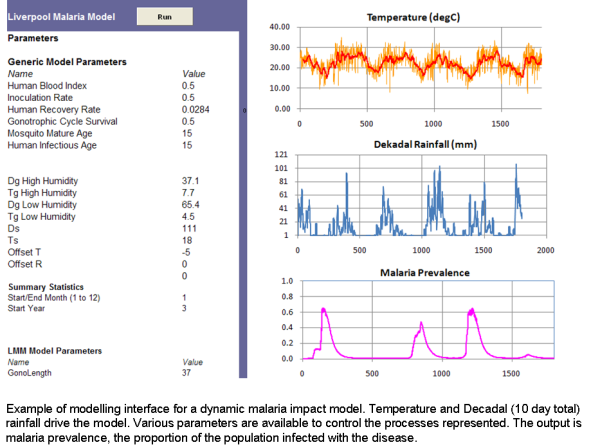Impacts over Coming Seasons | Impacts over the Next Century
Climate model output data can be used to make seasonal and decadal predictions of certain climate-sensitive impacts on human activity such as agriculture, energy production and health.
For example, malaria is a disease responsible for over one million deaths worldwide per year. Under certain conditions, cases of the disease are also highly sensitive to the temperature and moisture conditions experience by the anopheles mosquito vector responsible for transmitting the parasite between humans. By combining seasonal climate forecasts of the relevant variables with a model of the disease, early warnings of epidemic risk of diseases such as malaria can potentially be issued several months in advance. On a decadal time scale, changes in the distribution of climate-sensitive diseases are of considerable concern to health planners.
In the ENSEMBLES project, the use of multi-model, ensemble forecasts enables impact predictions to be accompanied by an estimate of uncertainty. The ensemble outputs from the climate models are used as input to other models which simulate the climate-driven processes of the particular impact. The resulting ensemble predictions of the impact variable (such as crop yield or disease cases), are then transformed into probabilistic forecasts, where the spread of the individual ensemble members indicates the confidence with which a warning (for example of famine or epidemic risk) can be given. Within the project, the climate model-driven impact predictions have been compared with impact simulations made using meteorological observations, and with observations of the impact variables themselves, in order to quantify the performance of the climate models in terms of these human-relevant applications.

Evaluation of the quality of climate model output is not the only goal of the impact studies; both the impact models and the integration process linking the two have also been assessed. In particular, integrating climate models and impact models is not a straightforward task. Impacts, and therefore models attempting to simulate them, often contain thresholds and non-linearities which make their sensitivity to climate highly complex. Data pre-processing, such as transforming the climate model output to the relevant spatial scales (“downscaling”) and removal of drift in the models’ mean climates (“bias correction”) are essential in order to provide realistic prediction of impacts. A further question is how to best combine the individual ensemble members on output from the impact model, in order to give the most accurate predictions through techniques known as “ensemble dressing” and “model weighting”. These methods have been refined and extended as part of the ENSEMBLES project.

For more information on seasonal prediction see ENSEMBLES newsletter Issue 2
